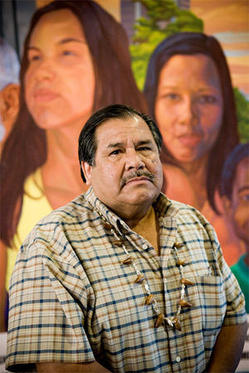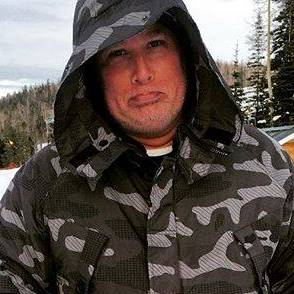
When the California Coastal Commission meets in Huntington Beach on Thursday, panelists will be staring into at least one familiar face: that of Chief Anthony Morales of the Gabrielino-Tongva Band of Mission Indians (pictured).
While the commission deals with coastal development issues up and down the state, their monthly meetings bounce around from city to city so they can be closer to all the people whose interests they allegedly represent. Following them from town to town for several months has been Morales, who resides in the San Gabriel Valley.
The chief is urging the commission to force the developer of Brightwater Hearthside Homes on the mesa overlooking the Bolsa Chica Ecological Reserve to more respectfully handle, and more quickly turn over, the remains of Native Americans unearthed or still buried under current and future residential neighborhoods.
His attempt to get the commission to pull the building permits they'd previously issued to Hearthside failed in November. But Morales did score one victory when he convinced the commission to order Hearthside to sort through 5,500 bags of dirt that have been sitting in trailers at Bolsa Chica and in Temecula for a couple years. The dirt came from state-ordered archaeological digs on the site.
]
Commissioners called Hearthside vice president Ed Mountford to approach that November morning in Long Beach City Hall and explain why it was taking so long to begin the process of sifting through the bags, which are believed to contain pieces of Indian bones, teeth and artifacts. After Mountford's “hummina-hummina-hummina” answer, he was told it was unfair that Morales has to shlep all over the state to update commissioners on the work Hearthside is supposed to be doing. Commissioners said they preferred to have Mountford update them–and soon–on the successful completion of the sorting task. State law and Indian custom require remains be reburied quickly.
Hearthside, after discussions with Morales, recently directed Scientific Resource Surverys, Inc., the developer's longtime archaeological research group out at Bolsa Chica, to sort through and catalogue the items in the bags by the end of this month. The chief, meanwhile, scored another victory in December when he convinced the California Native American Heritage Commission, which protects buried Indian remains and artifacts and was meeting in San Juan Capistrano, to join forces with the Coastal Commission to get Hearthside to properly deal with the 5,500 bags.
Morales had the right to ask for state assistance as a Tongva most likely descendant (MLD). It is believed Tongvas are among the Indians who lived in an ancient village on the mesa. But it was also populated by members of the Juaneno-Acjachemen Band of Mission Indians, and activists claim Hearthside is exploiting that distinction because the builder is tired of bowing to Morales' pressure.
“Hearthside Homes' attorney, Susan Hori, along with a tribal group, Juaneno Band of Mission Indian, Acjachemen Nation, led by David Belardes, have contacted the Native American Heritage Commission to question the appointment of a Most Likely Desendent, Chief Anthony Morales, at Bolsa Chica,” write Susana Salas and Paul Moreno in an email distributed to fellow Bolsa Chica preservation supporters. Before state agencies they call themselves “concerned Native Americans”; Salas is Yaqui, the native people of the northern Mexico state of Sonora, and Moreno is from the Micmac Nation of northeastern North America.
They claim Hearthside wants to deal exclusively with Belardes, the long-time Native American monitor at Bolsa Chica, so that bones that have been found can be buried and covered with dirt in the bags without first sorting through them and cataloguing what is found. The latter must first be done, Morales and his supporters claims, so the correct remains of an individual human being and his artifacts (and even pets) are matched and buried together–an obviously lengthy and expensive process.
The things is, Morales and Belardes appeared together at the December NAHC meeting and vowed they are in agreement on how to proceed with the bagged up remains. But there is long-standing distrust of Belardes in Orange County environmental and Native American circles because of his close association with builders of some of the region's most contentious developments. Seal Beach eco-activist Doug Korthof calls him “the ever-obedient Dave Belardes.” These controversies are believed to be at least partly responsible for the deep divisions within the Juaneno Band of Mission Indians that have prevented long-sought federal tribal recognition.
Korthof plans to join other environmental and Native American activists at Thursday's Coastal Commission hearing at Huntington Beach City Hall, City Council Chambers, 2000 Main St., Huntington Beach, and the weekly demonstration 10 a.m. Saturday at Bolsa Chica Road and Warner Avenue.
“This would be funny if not for how serious an issue this is,” he says. “Heathside Homes now must learn not to weasel and scheme, and learn to follow the law. . . . As Mr. Belardes will find out, his 'services' are not required.”
“We pray that this work gets completed,” says Salas.

OC Weekly Editor-in-Chief Matt Coker has been engaging, enraging and entertaining readers of newspapers, magazines and websites for decades. He spent the first 13 years of his career in journalism at daily newspapers before “graduating” to OC Weekly in 1995 as the alternative newsweekly’s first calendar editor.

